As an enthusiast about the intricate world of orchids, I am always fascinated by the detailed rhythms of their growth cycles.
The orchid life cycle is a remarkable journey, marked by distinct orchid growth stages that chart the path from a tiny seed to a stunningly beautiful flowering plant.
Rooted deep in the understanding of orchid growth cycles, I’ve nurtured my plants through each developmental phase.
Orchid development is governed by a natural sequence of growth stages, beginning with the remarkable process of seed germination or keiki development, transitioning into vigorous root growth, and culminating in leaf formation.
It’s thrilling to witness the emergence of a flower spike, signaling the impending phase of blooming where my orchids reveal their full magnificence. Orchid care throughout these stages is crucial, and my devotion ensures that flowering orchids in my care thrive, displaying their mesmerizing beauty to the fullest.
Post-bloom, the dormancy stage provides these delicate plants with a well-earned rest, completing the cycle, yet promising future bursts of floral splendor as the cycle prepares to renew itself.
Key Takeaways
- Understanding orchid growth cycles is fundamental for successful orchid care.
- There are six primary stages in the orchid life cycle, each vital to the plant’s development.
- Proper care during the root and leaf growth stages sets the foundation for robust flowering orchids.
- Monitoring and maintaining correct conditions during the flower spike growth leads to spectacular blossoms.
- Recognizing the importance of dormancy can help ensure the longevity and re-flowering of orchids.
- Each phase in the orchid growth stages offers a unique opportunity for care and connection with these enchanting plants.
Understanding Orchid Life Cycle Basics
As an orchid enthusiast, I’ve learned the importance of familiarizing oneself with the fundamental aspects of orchid life cycles to ensure their flourishing growth.
This knowledge is crucial in guiding us through nurturing these exquisite plants, from their infancy as keikis to their full maturation.
Let’s delve into the intricacies of seed germination, the significance of aerial roots, and the environmental impact on leaf production.
Seed Germination and Keiki Development
Orchid care begins with a thorough understanding of seed germination and keiki development. Keiki, Hawaiian for “baby,” refers to the offshoots that occasionally grow from a parent orchid.
These keikis can ultimately become independent plants, indicative of the orchid’s capacity for reproduction and longevity.
It’s fascinating to watch these miniature versions of adult orchids, each a promise of new life, form and gradually establish their own root systems.
The Role of Aerial Roots in Nutrition Uptake
Aerial roots are a phenomenal feature of many orchid species, fundamental for securing the plant to its support structure and crucial for hydration and nutrition uptake from the atmosphere.
These unique roots are a testament to the adaptability and resilience of orchids, thriving in environments where other plants might not.
They serve as an integral component of orchid stability and growth that, if managed correctly, greatly enhance the overall health of the plant.
Orchid Leaf Maturation and Environmental Influences
The leaves of an orchid are as vital as any other part, serving as indicators of the plant’s health.
The conditions surrounding an orchid, such as the amount of light received, temperature fluctuations, and humidity levels, play significant roles in the development and well-being of the foliage.
As someone attuned to these subtleties, I’m always adjusting my care regimen to ensure optimal leaf production and plant vitality over the course of the year.
To further illustrate my orchid care experience with aerial roots and leaf production, I’ve compiled a table that provides a quick reference guide on optimal conditions for nurturing these essential aspects of the orchid life cycle.
| Orchid Feature | Function | Optimal Conditions for Care |
|---|---|---|
| Aerial Roots | Nutrient and water absorption, support and anchorage. | High humidity, consistent misting, and secure attachment to a suitable structure. |
| Leaves | Photosynthesis, indicator of overall health. | Ample but indirect sunlight, temperature between 65-75°F, and adequate air circulation. |
Grasping the essentials of orchid care, including keiki development, the function of aerial roots, and optimal leaf production circumstances, empowers us to cultivate these magnificent plants with knowledge and precision.
Each step in assisting orchids through their growth stages with appropriate care tips can lead to a rewarding and blossoming orchid display.
Orchid Growth Cycles and Their Importance
As an aficionado of the elegant orchid, I am always captivated by the beauty that comes from their meticulous growth cycles. Seeing orchids blooming is merely the pinnacle of a complex series of stages that require thoughtful orchid care and maintenance.
From the careful sowing of seeds to the triumphant display of flowers, each phase in an orchid’s life demands a personalized approach to ensure vibrancy and health.
Orchids, with the right guidance, really can thrive for years within your home.
To demystify the essence of orchid care, let’s delve into a detailed examination of the conditions fostering the most spectacular orchid blooming.
Our orchid care guide emphasizes the necessity of regular, yet not overbearing, watering practices, matching the orchid’s natural preferences, and the strategic application of fertilizers to support growth.
With these orchid growth tips, success is not just possible, it’s expected.
Maintenance post-bloom is just as critical. After the orchid has flowered, we encourage gardeners to proceed with pruning spent flower spikes, allowing the plant to regenerate and ready itself for the next season of growth.
This is more than a mere trim; it’s about understanding your orchid and offering what it needs to rebloom time and again.
It’s clear that temperature, light, and even humidity have their roles to play in seeing your orchids flourish.
Be mindful of these environment factors—they can be the difference between a short-lived bloom and an enduring display that becomes a centerpiece in your living space.
The proper balance of these elements, paired with your dedicated orchid maintenance, might very well extend the lifespan of your cherished plants to an impressive decade indoors.

Here’s a quick reference guide to the essential phases of orchid care:
- Germination and Early Care: Orchids begin as seeds or keikis and require a nurturing start.
- Root and Leaf Development: Adequate support and nutrition lead to strong growth.
- Flower Spike Formation: Signals the orchid’s readiness to bloom, contingent on correct environmental stimuli.
- Blooming: The rewarding display that can last weeks to months, depending on care and orchid types.
- Post-Bloom Recovery: A critical period where your orchid replenishes and prepares for its next cycle.
By embracing these tips and incorporating them into your routine, you’ll find that growing orchids can be a gratifying long-term hobby.
It’s my hope that with these insights, your orchids will not only persist but will truly thrive, adding lush, colorful vibrancy to your surroundings for many years to come.
The Intricacies of Orchid Care to Foster Optimal Growth
As an orchid enthusiast, I’ve learned that the key to nurturing these exotic beauties lies in the minor details of their care.
Critical elements such as watering schedules, fertilizer application, and balancing environmental conditions all culminate to impact orchid health and its majestic blooms.
Tailoring these needs to the unique requirements of different growth stages can pivot orchid care from satisfactory to exemplary.
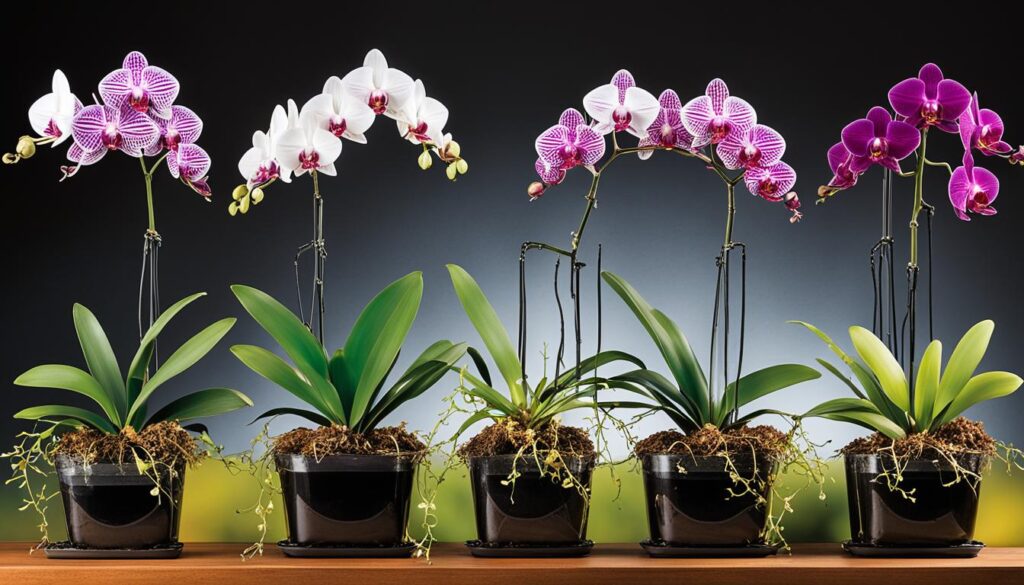
Watering Schedules and Fertilization Practices
Epiphytic orchids, like the beloved Phalaenopsis, thrive with meticulous watering that echoes their natural tropical conditions.
In my experience, a moderate approach is crucial, sufficient moisture without waterlogging to prevent root rot. The right balance is dependent on factors like the orchid’s growth phase, humidity, and air circulation.
When it comes to fertilization, less is more. A balanced, water-soluble fertilizer encourages vibrant growth without overwhelming the orchid with excess nutrients.
Pest Management and Environmental Controls
Constant vigilance is another aspect of orchid maintenance I uphold to thwart unwanted pests.
A gentle organic pesticide can be effective against common offenders without causing harm to the orchid. Moreover, creating an environment with stable temperatures and adequate ventilation is a vital practice for maintaining the well-being of these delicate plants.
By replicating its preferred habitat, my orchids have rewarded me with incredible blooms, time and time again.
Initiating Flower Spike Development
As a passionate cultivator of orchids, I find the initiation of flower spike growth to be one of the most exhilarating aspects of orchid care.
This stage signals the upcoming spectacle of orchid blooming and is a testament to the attentive care we give to our flowering orchids.
Achieving robust spike development requires patience and precision, but the result is a truly magnificent display of nature’s sophistication.
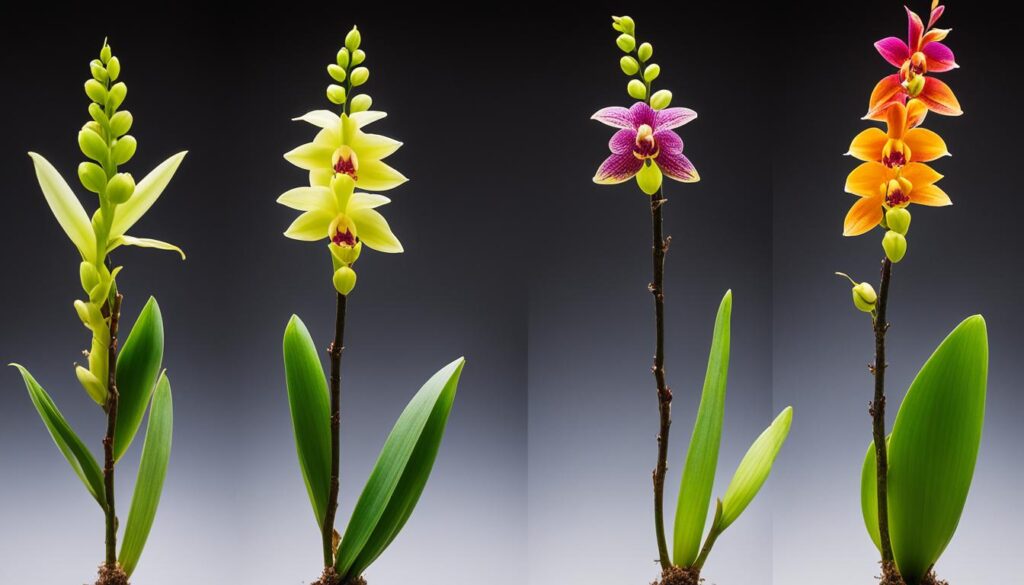
Timeframes for Spike Maturation
It’s important to note that the timeline for a flower spike to mature can vary. Generally speaking, it takes around three months for an orchid’s flower spike to fully mature, but this can differ among varieties.
A Phalaenopsis may take less time compared to a Cattleya or a Dendrobium. Still, it gives me immense joy to witness the slow but steadfast emergence of these spikes, knowing that each day brings us closer to vibrant flowering orchids.
Encouraging Flowering with Proper Pruning Techniques
My experience has taught me that proper pruning techniques can significantly encourage further orchid blooming.
When a spike starts to yellow or the flowers wilt, a careful cut just above a node can potentially induce another round of flowers.
It’s crucial not to underestimate the importance of strategic trimming, as it can prolong the blooming period of orchids and enhance their overall beauty.
- Trim above the first healthy node beneath the spent blooms
- Use sterilized pruning shears or scissors to prevent disease spread
- Provide support for new growth with stakes and clips
- Monitor your orchids closely to evaluate the effectiveness of your pruning
Through dedicated and well-informed orchid care, we can help our cherished orchids reach their full potential, blooming with an unmatched elegance that rewards our efforts with a stunning visual feast.
The Phases of Orchid Blooming
As an enthusiast of the orchid’s mesmerizing lifecycle, I find the process of orchid blooming to be particularly breathtaking.
Observing a bud burst into blooms is a highlight for any grower, marking a successful period of orchid development.
The transformation from a closed bud to a flourish of flowering orchids is the culmination of meticulous cultivation. Let’s explore the significant stages leading up to this spectacular event.
The first glimmer of success is seen when a spike emerges, indicating that the plant is entering a blooming phase.
This is a clear sign for gardeners to adjust their care regime to optimize the full potential of the bloom. The right balance of light, temperature, and humidity is essential during this time. Orchids reward attentive caregivers with an explosion of color and form for those who have mastered these conditions.
Now, let’s dive into a deeper understanding of these phases through a detailed look at the flowering timeline.
| Stage | Timeline | Description | Care Tips |
|---|---|---|---|
| Bud Formation | 1-2 weeks | Buds form and begin to swell, showing signs of future blossoms. | Maintain consistent watering and avoid relocating the plant to prevent shock. |
| Initial Bloom | 3-4 weeks | The first flowers open, marking the beginning of the blooming stage. | Provide ample light, but avoid direct sunlight that can damage the delicate petals. |
| Peak Blooming | 5-8 weeks | Orchids are in full bloom, with a stunning display of colors and patterns. | Ensure high humidity and adequate airflow to enhance flower longevity. |
| Bloom Decline | 9-12 weeks | Flowering gradually subsides as the orchid prepares for dormancy. | Reduce feeding to signal the coming dormancy and allow the orchid to rest. |
It’s essential to celebrate each phase, understanding that even as the flowers fade, the orchid is gathering energy for the next cycle of growth.
With this comprehensive approach to orchid care, the anticipation of each bloom becomes its own reward, fulfilling a journey of nurturing and patience.
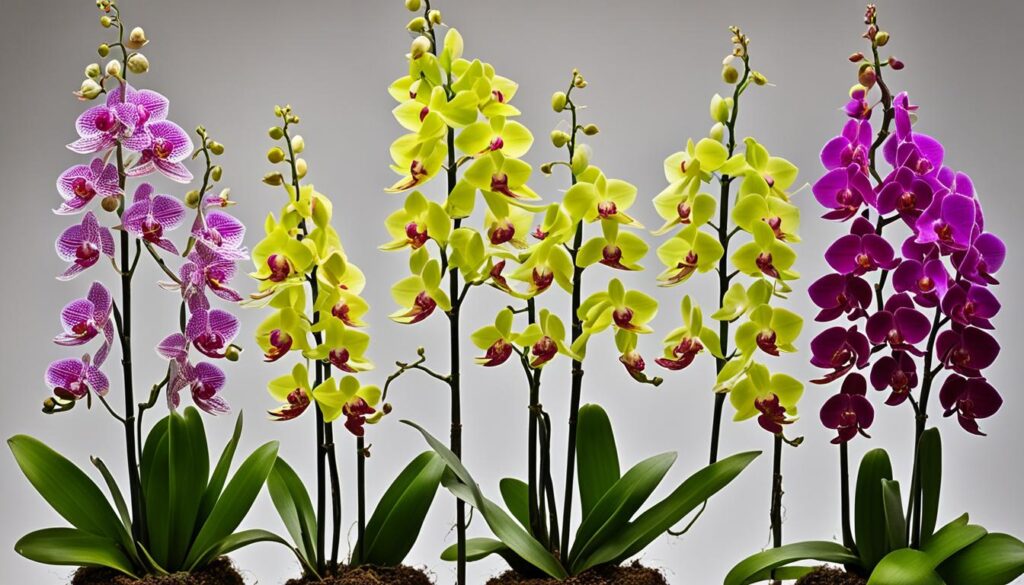
In the grand tapestry of orchid care, the blooming phase is a spectacle that serves as a testament to the grower’s commitment.
To be part of this natural marvel is a true privilege, and it keeps me, and surely many others, continually entranced by these exceptional plants.
Post-Bloom Care and Promoting Reblooming in Orchids
Mastering orchid care following the bloom period is crucial for gardeners aiming to achieve orchid reblooming.
The steps taken during post-bloom care can significantly affect the orchid’s ability to flower again.
Trimming the flower spike is one such contemplative act. Depending on the species and health of your orchid, trimming can be done to encourage a second bloom, or in some cases, it’s best to cut the spike close to the base to redirect energy to vegetative growth and root health.
Another essential aspect of orchid maintenance after the flowers have faded is the continued use of fertilizers.
However, it’s not just any fertilizer; I prefer a special blend tailored to the needs of orchids, specifically designed to encourage blooms.
This, in combination with monitoring and providing optimal light conditions and maintaining a consistent temperature range, paves the way for your orchid to not just survive but thrive and rebloom.
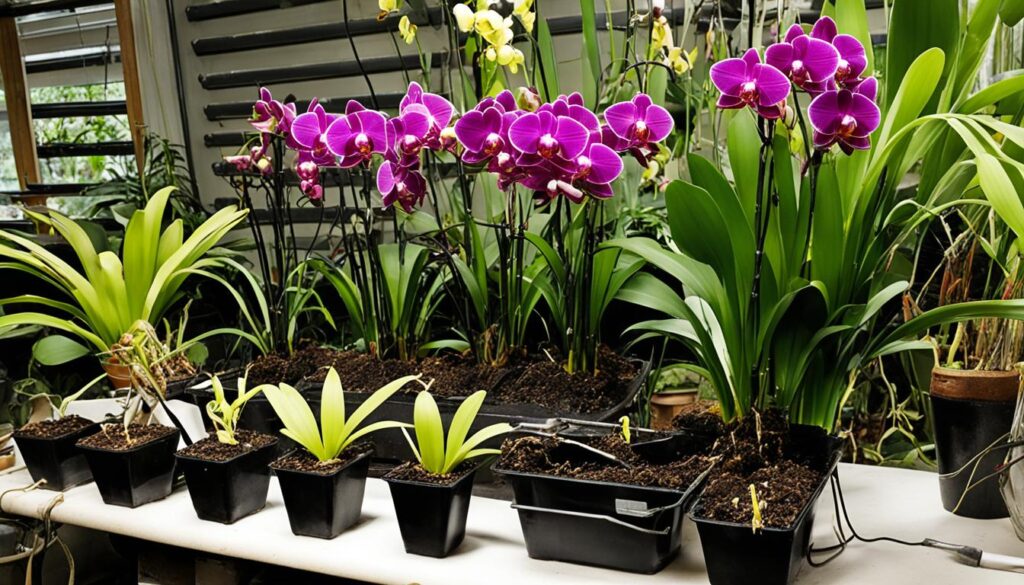
Careful tuning of the orchid’s environment, especially during its rest period, can lead to successful annual or even biannual reblooming.
This involves recognizing the unique bloom cycles of your orchid and adjusting your care routine accordingly. The magic lies in the observation and responsive care that caters to the orchid’s seasonal requirements.
Patience and attention to detail are the gardener’s best tools when it comes to post-bloom orchid care. The anticipation of witnessing a reblooming orchid is well worth the meticulous efforts invested in post-bloom maintenance.
- Trimming the flower spike for a second bloom vs. cutting it completely
- Application of specialized orchid fertilizers post-bloom
- Ensuring adequate lighting and temperature control
- Observing and adjusting care with the orchid’s bloom cycle
Every orchid enthusiast dreams of their plant reblooming, and while there’s no guaranteed formula, applying these tried and true post-bloom care tips increases the likelihood of experiencing the joy of your orchid’s spectacular flowers once more.
Unraveling Orchid Dormancy
As an orchid enthusiast, I’ve learned to appreciate every stage of the orchid life cycle, including the often-overlooked period of orchid dormancy.
This phase, critical for the renewal and future blooming of orchids, appears to be a time when the plant is unproductive, but in reality, it is a phase of crucial rest and rejuvenation.
Caring for Orchids During Rest Periods
During dormancy, it’s essential to modify your orchid care guide practices to support this rest period.
Reduce watering frequency significantly but do not let the orchid’s roots become desiccated. With cooler temperatures and less light in their dormant state, orchids require less fertilizer as well.
Maintain ambient temperatures and observe your plants closely without disturbing their rest too much.
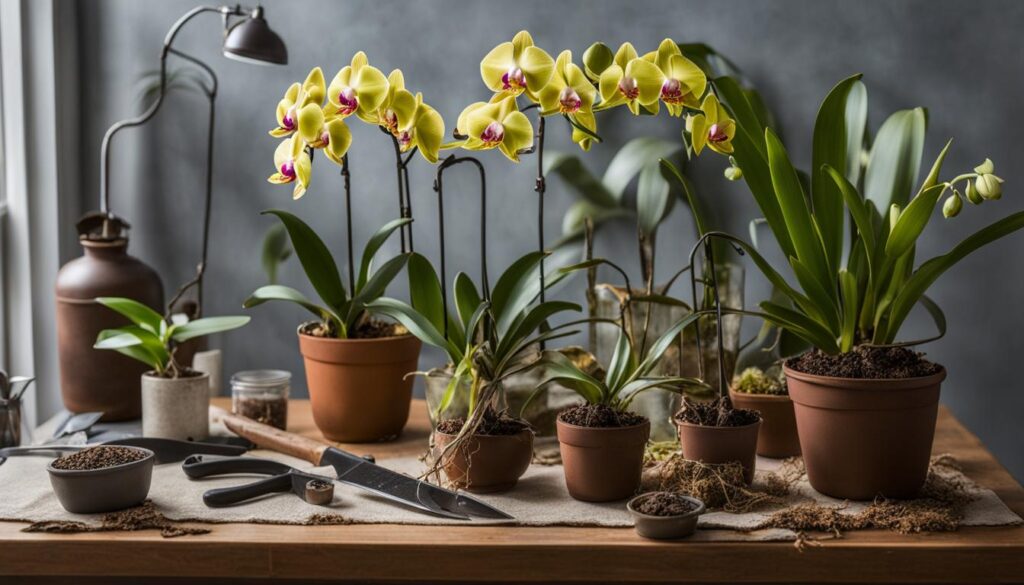
Signs an Orchid is Preparing to Exit Dormancy
As dormancy comes to an end, keen observation will reveal signs that your orchid is gearing up for new growth.
Look for fresh roots or a green tip on an existing spike, which heralds the start of the orchid’s active growth phase.
At this juncture, begin gradually reintroducing water and nutrients to welcome the orchid back to life.
Here’s a useful table on the transitions from orchid dormancy to active growth:
| Stage | Sign | Recommended Action |
|---|---|---|
| Dormant | Yellowing leaves, thinner stem | Reduce watering and fertilization |
| Pre-exit dormancy | New green shoots or roots | Gradually increase watering |
| Active Growth | New leaves or flower spike | Resume regular care schedule |
Understanding the subtle cues of orchid dormancy and how it fits into the broader orchid life cycle ensures that these exquisite plants receive appropriate care year-round, setting the stage for the lush blooms we all enjoy.
Conclusion
In my journey as a cultivator and admirer of these exotic beauties, I’ve learned that understanding the orchid life cycle is not just about the pursuit of perfect blooms; it’s about embracing a symphony of growth stages, each with its rhythm and requirements.
My experience has reinforced that meticulous orchid maintenance and a keen awareness of each developing phase, from germination to dormancy, are essential for the plant’s health and its spectacular flowering showcase.
For fellow enthusiasts seeking guidance, a comprehensive orchid care guide becomes an invaluable resource through the myriad stages of orchid development.
With the insights gained from such a guide, I’ve been able to nurture my own orchids, experiencing the rewarding cycle of dormancy giving way to rebirth and ultimately, the mesmerizing process of orchid reblooming.
Each success and setback has been a lesson, contributing to an ever-expanding knowledge base that enriches this delightful horticultural endeavor.
Each orchid’s progression stages hold a promise, a potential for prolonged vitality and aesthetic magnificence.
As the cycles persist and my orchids awaken from their rest, ready to embark once more on the journey from root to blossom, the sense of expectation and fascination renews itself.
So, it stands that the art of cultivating orchids is infinitely rewarding and perpetually inspiring, offering an ongoing canvas of color and texture for anyone devoted to their care.
FAQ
What are the primary stages in an orchid’s growth cycle?
The orchid growth cycle comprises six key stages: seed germination or keiki development, root growth, leaf production, flower spike growth, blooming, and dormancy. Each phase plays an essential role in the development and health of the orchid.
How do keikis contribute to an orchid’s life cycle?
Keikis are baby orchids that emerge from the mother plant, which can be used for propagation. The development of keikis is a crucial part of the orchid life cycle, offering a means to grow new plants genetically identical to the parent.
Why are aerial roots significant for orchid health?
Aerial roots are critical for an orchid’s survival, especially for epiphytic species. They absorb moisture and nutrients from the air and provide support by attaching to nearby surfaces. Proper care of aerial roots is key to a healthy orchid.
What environmental factors affect orchid leaf production?
Leaf production in orchids is significantly influenced by light, temperature, and humidity. Orchids require specific conditions to ensure healthy leaf growth, which can take up to a year to fully develop.
How important are orchid growth cycles to their overall vitality?
Orchid growth cycles are vital to the plant’s health and blooming potential. Following the right care procedures through each growth stage ensures that the orchid can flower annually and maintain its vitality over time.
What orchid care intricacies are essential for optimal growth?
Proper watering schedules, fertilization practices, pest management, and environmental controls such as adequate lighting and the right temperature are all intricate parts of care that foster an orchid’s optimal growth.
How long does it take for an orchid’s flower spike to mature?
An orchid’s flower spike maturation can range from a few weeks to about three months, depending on the species. Proper care during this time is crucial for the successful development of blooms.
What techniques can encourage orchids to flower?
Encouraging orchids to flower involves careful pruning of the flower spike, proper fertilization, and maintaining environmental conditions that mimic the orchid’s natural habitat. Pruning above a lower, healthy node after blooms have faded can promote additional flowering.
How can I care for my orchid after it blooms?
Post-bloom care for orchids includes trimming the spent flower spike, continuing to water and fertilize appropriately, and ensuring the plant receives sufficient light. This care encourages the orchid to rebloom in the future.
How do I know if my orchid is dormant, and how should I care for it during this time?
Signs of orchid dormancy include a reduction in growth, yellowing leaves, and a less vigorous appearance. During dormancy, you should reduce watering and fertilization until signs of new growth indicate the orchid is ready to exit the dormant phase and resume active growth.
What are the indicators that an orchid is preparing to exit dormancy?
Indications that an orchid is preparing to leave dormancy include the emergence of new leaves, roots, or a flower spike. These signs suggest that the plant is entering the next cycle of growth and is ready for regular care to resume.


Leave a Reply